Singapore is a small island country in Southeast Asia. It lies at the southern tip of the Malay Peninsula near the meeting of the South China Sea and the Indian Ocean. Singapore consists of a large island and more than 50 smaller islands. The large island, which is also called Singapore, covers over 250 square miles (650 square kilometers). The other islands have a combined area over 20 square miles (50 square kilometers). About half are uninhabited.
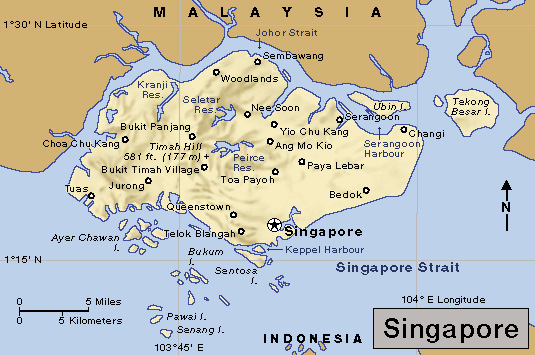
Singapore is a city-state—that is, an independent state consisting of a city and the region surrounding it. The majority of Singapore’s people are Chinese. Malays make up the largest minority group. Almost all the people live in the capital, which also has the name Singapore. The capital is a crowded, bustling center of trade, finance, and manufacturing. The city’s economic activity helps make Singapore one of the most prosperous countries in Asia. It is a vital port of Southeast Asia and one of the busiest ports in the world in terms of the weight of shipped goods handled each year.
Government
Singapore is a republic. A unicameral (one-house) Parliament makes the country’s laws. A prime minister leads a Cabinet, which carries out the operations of the government. Parliament has 93 elected members, up to 9 nominated members chosen by a select committee of Parliament, and up to 12 appointed members called nonconstituency members (NCMP’s). The NCMP’s are not associated with a specific constituency (political division). The members of Parliament serve five-year terms.
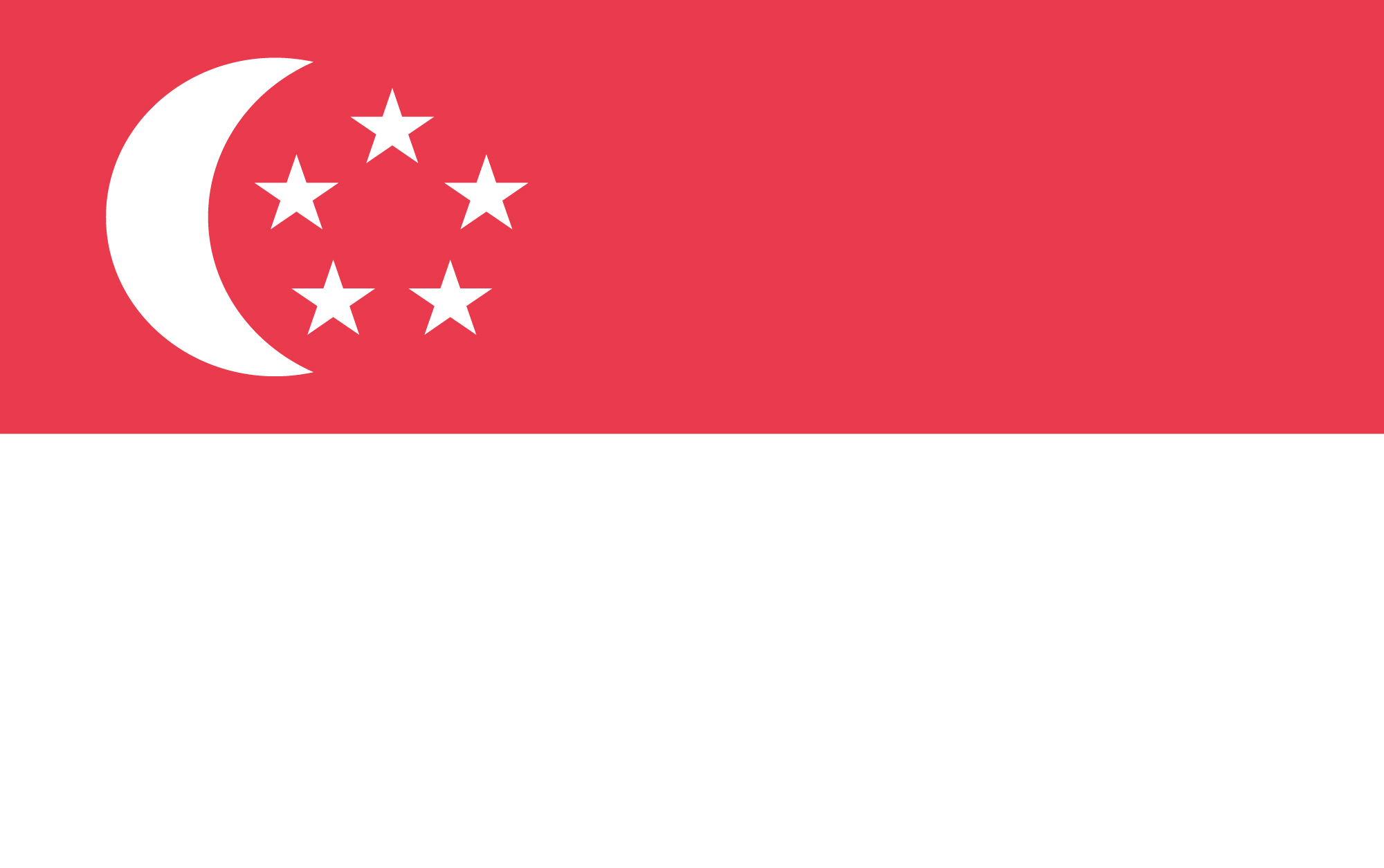
The people of Singapore choose the elected members of Parliament. Every citizen over 21 years of age must vote. The head of the political party with the most seats in Parliament serves as the prime minister of the country. The prime minister selects the Cabinet members.
The people elect a president for a six-year term. The president serves as head of state of Singapore. The president appoints the prime minister and the Cabinet members selected by the prime minister. The president also has some control over government finances and makes some civil service appointments.
The government of Singapore maintains tight control on people’s rights and freedoms. It censors what the news organizations may publish and bans satellite dishes on homes, which would enable Singaporeans to receive television broadcasts that the government does not approve. Residents of Singapore must have permits to gather publicly in groups larger than five.
Political parties.
Singapore’s largest political party is the People’s Action Party (PAP). It came to power in 1959. From 1968 to 1981, the PAP held all the seats in Parliament. Since 1981, it has held almost all the seats.
Courts.
Singapore’s judicial system consists of a Supreme Court and district, magistrate, and special courts. The Supreme Court consists of the High Court and the Court of Appeal.
Armed services.
Singapore has an army, navy, and air force. Men must serve two years in the armed forces after reaching the age of 18.
International relations.
Singapore belongs to the Association of Southeast Asian Nations (ASEAN). ASEAN is a regional organization that promotes economic, political, cultural, and social cooperation among its members. See Association of Southeast Asian Nations (ASEAN).
People
Singapore is one of the world’s most densely populated countries. About 75 percent of Singapore’s people are Chinese. Malays make up about 15 percent of the population, and most of the rest of the people are Indians. Many foreign workers also live in Singapore. Singapore has four official languages—Mandarin Chinese, English, Malay, and Tamil.
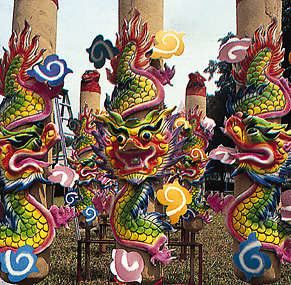
Religion.
Singapore has no official religion. The country’s Constitution guarantees freedom of religion. The main religions practiced are Buddhism, Islam, Christianity, Taoism, and Hinduism. Most of the Chinese in Singapore practice Buddhism or Taoism, and most Malays are Muslims. Hinduism ranks as the main religion among the Indians of Singapore, and Christianity is the dominant faith among the Europeans. The people and government of Singapore observe festivals of the country’s religious and ethnic groups as celebrations and public holidays.
Education.
Beginning in 2003, all children who were citizens living in Singapore were required to enter primary school at age six. Students attend six years of primary school and four or five years of secondary school. In addition to English, children also learn one other official language, usually the native language of their family. For example, all Chinese students must learn Mandarin as their second language. About 50 percent of people in Singapore are literate (able to read) in two or more languages.
Colleges of higher education include the National University of Singapore, the Nanyang Technological University, and several technical schools.
Clothing.
Singapore’s ethnic groups create a variety of clothing styles within the country. Most people wear Western-style clothing, but many Indians and Malays prefer their traditional dress.
Food.
Restaurants in Singapore offer a variety of Chinese, Indian, and Malay dishes. Western foods are also available, including American-style fast foods. The larger hotels and restaurants also serve a variety of international foods, including Mexican, Thai, and Vietnamese.
Culture.
Art, music, and theater reflect the cultures of the various groups. Cultural events include Chinese operas, Indian dancing, and Malay dramas. Performances by the Singapore Symphony Orchestra are also popular. The annual Singapore Arts Festival brings international dancers, musicians, and artists to Singapore.
The city of Singapore
The city of Singapore lies on the southern coast of Singapore island. Singapore is one of the world’s busiest ports. Ships sailing to Australia, China, and Japan dock there to load and unload cargo. Singapore is a free port—that is, goods can be unloaded, stored, and reshipped without payment of taxes on the items.
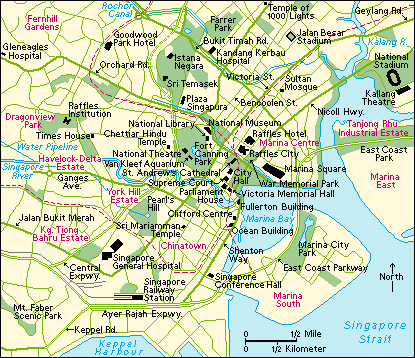
The city is built around its harbor. Warehouses and concrete docks line the port. In the crowded commercial section, modern skyscrapers tower over traditional Chinese shops. Singapore has many handsome buildings that date from the 1800’s, including the National Museum and the Raffles Hotel. The Jurong area, an industrial park west of the city, has thousands of companies, which operate many factories. The Botanic Gardens feature large collections of tropical and subtropical plants.
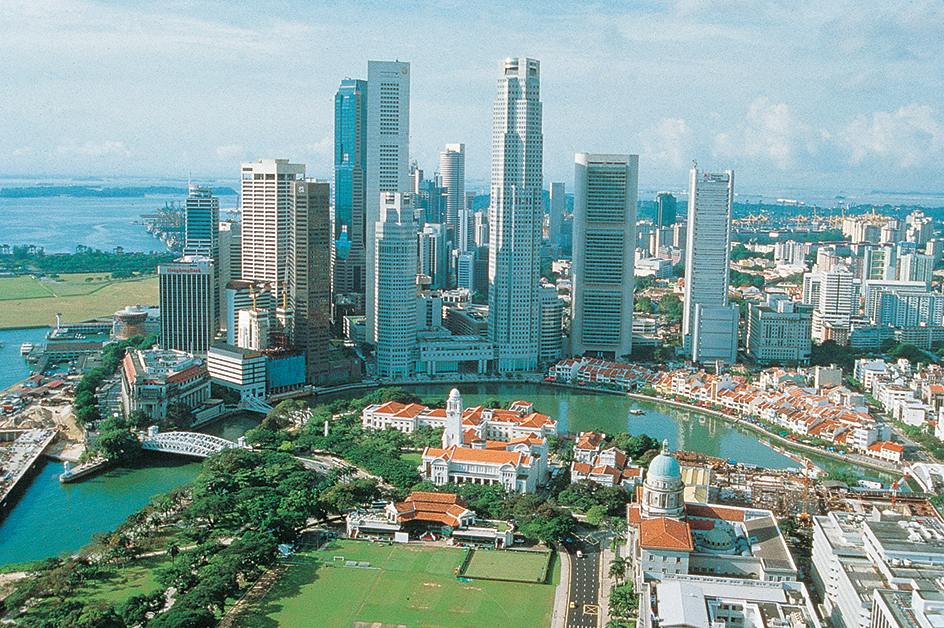
Housing.
As the British began the development of Singapore’s port in the early 1800’s, immigrants settled around the harbor area. Colonial planners assigned a separate section of the city to each of the major ethnic groups.
In Chinatown and in other ethnic sections, people built shophouses. These buildings, usually two stories high, stood on long, narrow plots of land. The ground floor was used for business purposes—the shop—and the upper floor provided living space—the house. The shop had a narrow front opening onto the street. The back of the building was used for storage.
During the late 1800’s and 1900’s, more and more migrants arrived in the country. Many of these new settlers crowded into the central area of the city. People added extra rooms on top of, or on either side of, existing shophouses. They divided their living space into tiny cubicles. In this way, a building designed for one family became home to as many as seven families. This overcrowding caused public health and sanitation problems.
By the late 1940’s, overcrowding in the central area had spilled over into surrounding districts. Singapore had one of the world’s worst slum problems. Squatter settlements (illegal houses) sprang up around the city’s center. Wealthy residents moved out of the city center and built new homes in outlying districts. There was no low-cost public housing for poorer residents.
In 1960, the Singapore government established the Housing and Development Board (HDB), which moved people from slum and squatter housing in the central and fringe areas of the city to low-cost public housing. The new homes were in high-rise developments called housing estates. These were modeled on the new towns built in some European countries in the 1950’s. Each development housed from 1,000 to 5,000 families. Each of these areas had its own schools, markets, shops, and playgrounds. The developments were within commuting distance of the main employment areas within the central area of the city.
Since the creation of the HDB, the government has built many thousands of housing units. Much of the public housing is in areas called new towns. These are larger than the housing estates and have their own town councils. About 85 percent of Singapore’s citizens live in public housing in every part of the island. Singapore has designated older traditional areas and buildings as conservation sites. The colonial heart of the city, including the Raffles Hotel, Chinatown, Little India, and the Malay district known as the Kampong Glam, has been preserved. In addition, some historic areas, such as the shophouses of Chinatown, have been restored.
Land and climate
Most of the islands of Singapore lie near sea level. The highest point, Timah Hill, is only 581 feet (177 meters) above sea level. Only 2 percent of Singapore’s land area is used for farming.
Plants and animals.
Human settlement in Singapore has altered the country’s vegetation. Rain forests once covered the main island. But most of the forest was cut down as Singapore grew into a prosperous British trading settlement. Settlers removed trees to make way for crops, such as nutmeg, cloves, pepper, and gambier, a tropical plant used to make dye. Later, the settlers established rubber and coconut plantations. Rain forests now cover most of the central part of the main island, and mangrove swamps lie along the northern coast.
Large wild animals, such as tigers, wild boar, mouse deer, and anteaters, once roamed Singapore’s forests but are no longer found. Most of them have become extinct because of urban development. Small mammals now found in Singapore include monkeys, squirrels, and civets (small, furry mammals that resemble cats). Birds and reptiles, including monitor lizards, pythons, and cobras, are also common.
Climate.
Singapore has a hot, humid climate. The average annual temperature is about 80 °F (27 °C). However, sea breezes cool the country, and so the temperature rarely rises above 94 °F (34 °C). The main island receives about 95 inches (241 centimeters) of rain yearly. The wettest months are from November to March, when the northeast monsoon (seasonal wind) blows. The dry season is from June to October. Thunderstorms are common in the months between the monsoons.
Although rainfall is plentiful, Singapore lacks enough water to meet all its demands. The country buys water from the state of Johor in Malaysia to supplement stocks in its own reservoirs.
Economy
Before the 1960’s, Singapore was essentially a trading nation. Since then, it has developed a more varied economy and has become an important financial, trade, and transportation center. Singapore has many banks, insurance firms, and finance companies, as well as a stock exchange. Tourism is also important to the economy of Singapore.
There is little unemployment in Singapore. The country’s annual income per capita (per person) is one of the highest in Asia.
The government of Singapore plays a major role in the country’s economy. For example, it decides what benefits, such as vacation time and sick leave, must be provided for workers by employers. It also operates an employment agency to help people find jobs, and it provides pensions for retired workers.
Manufacturing.
Singapore is a major manufacturing center. Its factories produce chemicals, electrical and electronic equipment, machinery, rubber and plastic products, telecommunications equipment, televisions, and transportation equipment. It is also a major center for food processing, petroleum refining, and shipbuilding and repairing.
Singapore has few natural resources, and so it must import most of the raw materials needed for manufacturing. Singapore imports oil for its petroleum refining industry, which is one of the world’s largest. Singapore has several refineries, and the country’s location allows it to ships its petroleum and petrochemical products easily.
The government of Singapore established the Economic Development Board in 1961 to promote industry as the key to economic growth. The Jurong industrial park was created in the western part of the island. The industrial program initially focused on labor-intensive manufacturing to help solve unemployment problems in the 1960’s. After this program succeeded, Singapore moved into higher-skill industries. In the 1980’s and 1990’s, the government concentrated on electronics and other high-technology industries. By the early 2000’s, the government had begun focusing on the life sciences, including biotechnology.
Agriculture
has a minor role in Singapore’s economy. Many local farmers are adopting advanced methods, such as hydroponics (growing plants in chemical solutions without soil), to boost food production. Farmers produce eggs, fruits and vegetables. They grow orchids for domestic use and for export. Marine fish farming along the coastal waters of Singapore is increasing in importance. Singapore also produces aquarium fish for export.
Trade.
Singapore is a leading importer and exporter. Singapore imports a wide range of goods, including chemicals, electrical goods, food products, machinery, and petroleum. Singapore exports electrical and electronic components, machinery, petroleum products, rubber, and telecommunications equipment. Singapore’s main trading partners are China, Japan, Malaysia, South Korea, Taiwan, Thailand, and the United States.

The import and export activities in the port area provide jobs for many people. Singapore is also a storage and distribution center for the Asian and Pacific regions.
Tourism
is a major industry. Millions of tourists visit Singapore each year. Tourists come mainly from Australia, China, India, Japan, South Korea, Taiwan, the nations of Southeast Asia, the United Kingdom, and the United States. Singapore has a wide range of hotels, with branches of many major international hotel chains.
Transportation and communication.
Singapore’s roads are crowded because of the large number of cars. Drivers must pay a fee to enter the city during peak periods on workdays. This system has helped reduce traffic congestion at busy periods. Singapore’s Mass Rapid Transit, established in 1987, offers a fast and efficient local railroad service. Buses also provide transportation for city workers.
Singapore has well developed transportation links with other countries. A bridge and a causeway, a raised roadway that includes a road, railroad, and water pipeline, link Singapore with Malaysia. Singapore has one of the world’s busiest ports. Changi International Airport, at the eastern end of the island, is the nation’s chief airport and one of the most modern airports in the world.
Singapore has several daily newspapers, at least one of which is published in each of the four official languages. The English-language The Straits Times is the largest newspaper. Radio and television stations broadcast in all four official languages.
History
Historians do not know when people first lived in Singapore. Some archaeological evidence on the mainland dates back to about A.D. 1300.
Early settlement.
In the 1300’s, Singapore and the islands around Sentosa were known as Temasek or Tumasik, which means place surrounded by water. During this time, Singapore Harbour served as a trading center. A Chinese trader and author, Wang Dayuan, wrote an account in 1349 of his visit to the island. He described two different groups of people living in Temasek. The first group lived at a place called Long Yamen (Dragon’s Tooth Strait), at the narrow western entrance to Keppel Harbour between Labrador Point and Sentosa Island. These people were fearsome pirates who were known for massacring their captives.
The second group lived at Ban-tzu, closer to the main island. This group consisted of peaceful traders. Wang Dayuan described the settlement of Malays and Chinese on terraced hillsides protected by a defensive wall. The wall protected the people from pirates and from attacks by the kingdom of Majapahit, an empire in eastern Java that sought to control Singapore (see Majapahit). Wang also mentioned that the Hsien, a people from what is now Thailand, once laid siege to the port of Ban-tzu but failed to conquer it.
The entrance to the Singapore River served as a trading center. Groups from what are now the Malaysian states of Melaka and Johor used Singapore as a base. A group of people called the Orang Laut (sea people) lived in houseboats near the coast and earned a living by fishing.
About 1390, a Sumatran prince named Parameswara who lived in Palembang killed the local chief and took over the area. By 1400, the city had become known as Singapura, which means lion city in the Sanskrit language. The origin of the name Singapore is not known with certainty. Lions are not native to Singapore. Some theories state that Parameswara gave the name Singapore to the city and its surrounding islands. The name was a common one in ancient Southeast Asia. One of the oldest kingdoms in the region, which existed in what is now Tra Kieu, Vietnam, around A.D. 400, was the first to be called Singapura. The name may have been connected with Buddhism. Buddha was often symbolized by a lion in ancient Indian art, and his voice was said to resemble a lion’s roar.
Parameswara ruled Singapore for only a few years before Majapahit or Thai forces drove him out. He fled to Malaka on the Malay Peninsula, where he established a sultanate. Malaka was captured by the Portuguese in 1511. The rest of the sultanate’s followers moved to the southern end of the Malay Peninsula. Singapore existed as an outpost of the sultanate until the Portuguese destroyed it in 1613. A Portuguese map of 1574 shows that a harbormaster still lived in Singapore at that time.
The arrival of Raffles.
In 1819, Sir Thomas Stamford Raffles, an official of a British trading company called the British East India Company, arrived to set up a trading post in the south of the Malay Peninsula. The Dutch controlled the trade routes with China and the East Indies, and Raffles wanted to establish a British trading base to end Dutch control. Raffles and his assistant, William Farquhar, anchored off Singapore on Jan. 28, 1819, and went ashore the next day. Raffles received permission to establish a trading post for the United Kingdom through an agreement with Temenggong Abdul Rahman, the local chief of Singapore, and Sultan Hussein, the ruler of Johor.
Singapore was an immediate success as a trading center for the British and soon became a center of free trade for the region. Traders from China, India, and Indonesia came to the new settlement. Bugis traders from Celebes (now the island of Sulawesi in Indonesia) collected such goods as spices, coffee, edible birds’ nests, gold dust, ivory, rice, and exotic birds, such as parrots. The traders brought the goods to Singapore to sell or trade for manufactured goods. Chinese traders brought silk, tea, and porcelain.
The town plan.
The original small population grew quickly. The number of Chinese and Malays was estimated to be almost 5,900 in 1821. By 1824, the population had reached nearly 11,000. Among the immigrants who settled in Singapore were Arabs, Armenians, Chinese, Europeans, Indians, and Malays. Chinese junks (sailboats) and large sailing ships from Europe began to come to Singapore. In the riverside settlement, the people lived in rough huts and houses, and there was much violence and disorder.
In 1822, Raffles drew up a town plan for Singapore. Each community was given a kampong (village section) of its own. There were kampongs for the various ethnic groups, as well as government and commercial districts. This historical division continues somewhat today. For example, modern Chinatown grew from the original Chinese kampong.
Growth of trade.
The old port on the Singapore River was soon too small for Singapore’s booming trade and inconvenient for steamships. In the 1850’s, shipping companies built facilities at New Harbour along the southern coast. The harbor was renamed Keppel Harbour in 1900.
Trade continued to grow, and the importance of the port of Singapore increased after the opening of the Suez Canal in 1869. The canal greatly shortened the distance between London and Singapore. In addition, ships that formerly used the Sundra Strait to travel between Europe and the Far East began using the Strait of Malacca instead. This route took them directly past Singapore, which soon became a major port for ships trading between these two regions. Products from the Malayan mainland, such as tin and rubber, gave the port a further boost. Singapore’s New Harbour became a coaling station for steamships and provided dry docks for ship repair.
The growth in trade and population prompted the British East India Company to acquire all rights to Singapore. In 1824, Temenggong Abdul Rahman of Singapore and Sultan Hussein of Johor sold their control of the island to the British. Two years later, Singapore was united with Penang and Melaka to form the Presidency of the Straits Settlements. It was ruled by British administrators in India. In 1867, the Straits Settlements became a British crown colony, ruled by the British government in London.
Piracy and crime.
Singapore’s trade attracted pirates from the Sulu archipelago (group of islands) and Mindanao, both in the Philippines. Some pirates even attacked ships in Singapore’s port and then traded their loot openly in town. In 1832 and 1833, Chinese merchants sent armed boats to patrol outside the harbor. In 1836 and 1837, the British dispatched two ships to destroy the pirates. In the 1850’s, there were more attacks by pirates, this time from China.
Violence was also widespread in the town. The small police force could not control the problems of murder, theft, and Chinese secret societies, groups that preyed on immigrants and supported crime and prostitution. In 1843, the British government appointed Thomas Dunman as the first superintendent of police. Dunman greatly improved Singapore’s police force, but its job was overwhelming. The Chinese secret societies promoted lawlessness and riots until a law was passed in 1889 making the societies illegal. Even after they were outlawed, they continued to be a menace until the mid-1900’s.
In an effort to end the domination and abuse of immigrant labor by Chinese secret societies, the British established the Chinese Protectorate in Singapore in 1877. The Protectorate was an administrative department that worked specifically on difficulties within the Chinese society in Singapore. William Pickering, the first British official who could speak and read Chinese, was appointed the first protector. Chinese leaders accepted him as a mediator in their disputes, and he worked to suppress gambling and eliminate forced prostitution.
Treatment of immigrants.
Pickering also worked to end the poor treatment of Chinese immigrants. Poor Chinese laborers would register in China for a free passage to Singapore. Some others were tricked or kidnapped. Immigrants were packed into crowded ships in such horrible conditions that many died during the voyages. When the immigrants landed in Singapore, those immigrants who were healthy enough to work had their passages paid by employers. The immigrants had to work without pay a year or more to pay back their passage. The secret societies recruited new immigrants as members and demanded their loyalty. After the establishment of the Chinese Protectorate, British officials controlled the immigrant trade.
Many of the Indians who came to Singapore were sent there as convicts. Singapore was used as a penal colony of India from 1825 to 1873. The convicts often worked as laborers, constructing roads, canals, and public buildings. While serving their sentences, the convicts were taught useful trades, such as brickmaking, carpentry, and construction, which allowed them to find work when freed.
Other Indian immigrants operated shops or worked at transportation facilities, such as docks or railroads. One group worked as moneylenders, while others became police officers. Many Indian immigrants were men who lived in rooms above the shops where they worked. Typically, they did not have wives and families or did not bring them from India.
Malays did not immigrate to Singapore in as large numbers as the Chinese or Indians. For this reason, they were soon outnumbered. The original Malay community was divided into followers of the temenggong (local Malay chief) and followers of the sultan. Each group was sent to a separate location. The Orang Laut people mixed with the Malay population, though some still maintain their identity today.
Immigrant society.
Many immigrants of the 1800’s were men who went to Singapore with the goal of seeking their fortune and then returning home. Few women came among the Chinese and Indian immigrants. The British provided few social services for the growing Asian population until the 1900’s. Instead, local community leaders set up religious buildings, schools, and hospitals. Narayana Pillay, a Hindu clerk who had arrived with Raffles, established the Sri Mariamman Temple in 1827, the oldest and most important Hindu temple in the country. In 1844, a rich merchant, Tan Tock Seng, paid for a hospital for the poor. A Melaka boat owner, Hajjah Fatimah, was the first woman to build a mosque. This Islamic place of worship, constructed in the 1840’s, still bears her name.
Raffles encouraged the construction of a school, the Singapore Institution, in 1823. It was finally completed in 1835 and was renamed Raffles Institution in 1868. Private charities and missionaries also set up schools. But Singapore did not have a universal education system in the 1800’s. There was little demand for good schools, and the government did not provide money to create them.
Some wealthy Chinese sent their sons to school in China, where they could strengthen their ties with Chinese culture. Other Chinese enrolled their sons in English-language schools in Singapore to improve their career prospects. Some schools existed that held classes in the Chinese, Malay, or Tamil languages. But these schools taught at an elementary level and generally had low standards. Education was especially lacking among immigrant girls, who often did not attend schools at all. Illiteracy (the inability to read) was widespread among them. Not until the early 1900’s did the colonial government make a significant effort to improve education.
The education system in colonial Singapore separated the different groups in the Asian population. The English-educated people had better jobs and a higher status in society. The rest, particularly the large numbers of Chinese-educated people, were restricted to professions in which they could speak their native language.
Economic development.
Singapore’s economy grew rapidly in the 1800’s. Most businesses were either British or Chinese. The British firms were often merchant houses or trading firms. By 1867, 60 European companies operated in Singapore. The Chinese businesses tended to be smaller and family-owned, though some grew large and made their owners wealthy. Chinese firms were often involved in agriculture, shipping, and trade. Kim Seng and Company, a trading company, was a leading Chinese business in the 1800’s. There were also Indian, Arab, and Malay merchants.
The close economic links with mainland Malaya formed the mainstay of Singapore’s flourishing trade. British rule had brought law and order to Malaya. Between 1874 and 1914, all the states in Malaya came under British rule.
The tin and rubber industries of Malaya gave Singapore’s economy a great boost. Tin smelting became one of the first modern industries in Singapore. A smelter operated at Pulau Brani, an island off Singapore. Tin soon became one of Singapore’s major exports. Another major export was rubber, which was greatly in demand for automobile tires.
By 1903, Singapore was one of the world’s largest ports in weight of goods shipped. To modernize the port, the government took it over in 1905. By 1917, the Singapore Harbour Board had constructed two large docks. Entrepot trade, in which imported goods and produce were processed or repackaged and shipped back out, was Singapore’s more important kind of trade.
The 1920’s and 1930’s.
As the economy continued to grow in the 1920’s, a large number of immigrants entered Singapore. Many came from China. This immigration trend reversed when trade slumped during the Great Depression of the 1930’s. The government sent thousands of people back to India and China, and reduced the number of immigrants allowed in. Only women were accepted without restrictions. A unique group of single women came as laborers from Sam-Sui in Guangdong, south China. In their distinctive red headgear and navy-blue samfoo (tunic and pants), they could be seen on construction sites doing heavy manual labor. Other women worked as domestic servants. Most Indian women moved to mainland Malaya to work on the rubber plantations.
New social and political leaders emerged from the late 1800’s into the early 1900’s. The Chinese-born businessman Tan Kah Kee helped found schools in Singapore. Lim Boon Keng, a Chinese doctor, led a Confucianist movement in Singapore and encouraged his fellow Chinese to learn and study their own language and culture. Mohammed Eunos bin Abdullah, a Sumatra-born political leader known as “the father of Malay journalism,” established newspapers for the Malay community. He also helped found the political party Kesatuan Melayu Singapura (Singapore Malay Union).
Many people still held loyalties to their own homelands. In 1931, Japan invaded Manchuria. In response, many Chinese in Singapore boycotted Japanese goods and raised money for an aid fund. Many young Chinese returned to China to fight the Japanese.
World War II
(1939-1945) and the Japanese occupation, which lasted from 1942 to 1945, had a great effect on the people of Singapore. In the 1920’s and 1930’s, the British built air bases and a naval base on Singapore island. The world’s largest dry dock, King George VI Graving Dock, opened in 1938. The heavily guarded British naval base was a symbol of British imperial power. The British and Singaporeans felt safe from any invasions, because of the British defenses and the heavy jungle to the north. But the base provided no defense against a land invasion. On Dec. 8, 1941, Japanese troops landed at southern Thailand and northern Malaya. They quickly marched toward Singapore, forcing the British to retreat onto the island by Jan. 31, 1942. On Feb. 15, 1942, the British defenders of Singapore surrendered to the Japanese. For the United Kingdom, the fall of Singapore was a catastrophe. In Singapore, the Japanese instituted a reign of terror and executed people who had helped the Allies against the Japanese. Life was hard for almost everyone in Singapore, especially the Chinese.
Toward independence.
Japan surrendered in August 1945, and British forces returned to Singapore on Sept. 5, 1945. The United Kingdom dissolved the Straits Settlements in 1946 and made Singapore a separate crown colony. The return of the British authorities after the war did not bring immediate improvement to the people of Singapore, however. Food shortages and soaring inflation added to people’s misery. Communists who had fought against the Japanese became louder in their demands for workers’ rights. Strikes became common. Chinese-educated people saw themselves at a disadvantage. Without speaking English, they could not join the civil service or find other jobs. Higher education was not available to Chinese until Tan Lark Sye, a Chinese-born merchant, helped found Nanyang University for them. The Communists recruited many students at the university to join their party. Student sit-ins and boycotts of classes, often involving clashes with the police, drew attention to their cause.
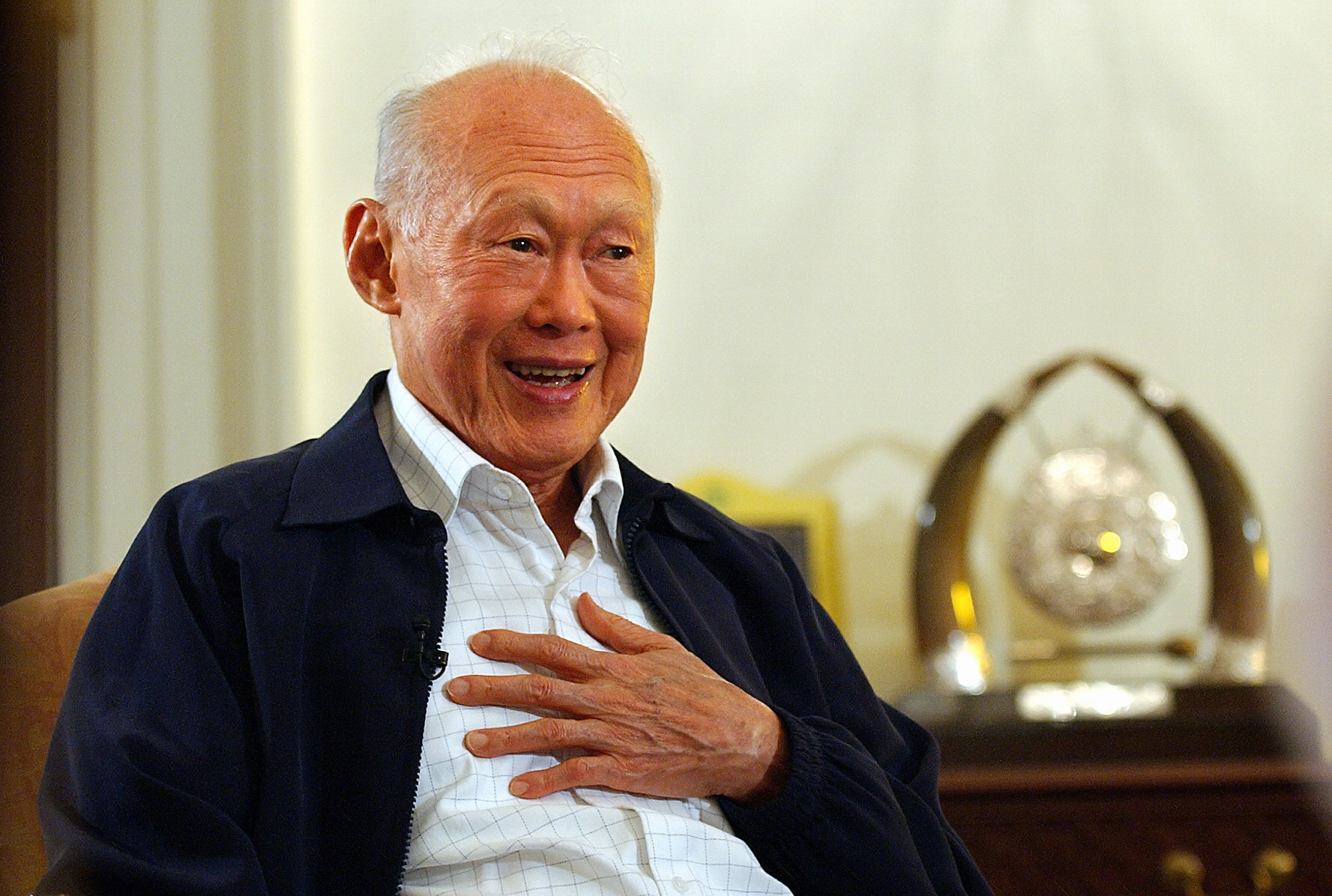
Soon after the war ended, political parties began to form. Among the most important were the Singapore Progressive Party and the Singapore Labour Party. These rival parties both believed in eventual self-government for Singapore.
One party that formed in the postwar years played a vital role in Singapore’s future. This was the People’s Action Party (PAP). It was led by Lee Kuan Yew, a Singapore lawyer who joined the Communists to fight colonialism. In 1954, he founded the PAP. Singapore set up its first legislative assembly in 1955.
In the 1950’s, the PAP worked for immediate independence from the United Kingdom and a union with Malaya. Malaya became independent in 1957. In 1959, Singapore gained internal self-government, with Lee Kuan Yew as prime minister. The United Kingdom retained control of defense and foreign affairs.
Federation.
Singapore’s leaders believed the country needed union with Malaya to survive commercially. On Sept. 16, 1963, Singapore joined the Federation of Malaysia, which also included Malaya and the Borneo territories of Sabah (formerly North Borneo) and Sarawak. However, economic and political disputes soon developed between Singapore and the rest of Malaysia. Relations worsened as Singapore’s leaders tried to become involved in Malayan politics, an action that was not welcomed by Malay leaders. Racial riots broke out in Singapore in 1964. When relations did not improve, the Malaysian prime minister asked Singapore to leave the federation. On Aug. 9, 1965, Singapore became independent. The first Singapore Parliament met in December 1965.
Independence.
The new government of Singapore drew up ambitious plans for the survival of the new nation. The government set educational standards and required students to learn English as well as their native language. The government revised the school curriculum to provide workers with the skills needed by the new manufacturing industries. The Housing and Development Board helped provide low-cost housing for many Singaporeans.
In the 1960’s, Singapore’s economy became much more diversified. Health and social services improved. In 1971, the British government withdrew the last British military forces from Singapore. Singapore’s economy continued to grow. By the 1980’s, it had become one of the most stable and prosperous nations in Asia.
Recent developments.
In 1990, Lee Kuan Yew retired as prime minister. He was succeeded by the first deputy prime minister, Goh Chok Tong. In 1993, Ong Teng Cheong became the first directly elected president of Singapore. He had previously held office as a deputy prime minister. Ong served only one term. In 1999, the Elections Commission disqualified all but one of the presidential candidates, S. R. Nathan, a former Singaporean ambassador to the United States. The commission declared Nathan the winner and canceled the election.
In 2000 and 2001, the government took some steps toward allowing greater freedom of speech. It created a speakers’ corner in a public park and allowed an outdoor opposition rally for the first time.
In 2004, Goh resigned as prime minister and was replaced by Deputy Prime Minister Lee Hsien Loong, the son of Lee Kuan Yew. In 2006, the PAP again won the most seats in Parliament, and Lee Hsien Loong remained prime minister.
In 2005, the Elections Commission granted S. R. Nathan a second term as president. The commission members canceled the scheduled election after finding the other presidential candidates ineligible. In 2011 elections, the PAP won the most seats in Parliament. Following the election, Lee Kuan Yew and Goh Chok Tong announced that they would retire from politics to make way for a new generation of leaders. Later in 2011, voters elected former Deputy Prime Minister Tony Tan to the presidency. The PAP retained its parliamentary majority following elections in 2015 and 2020. Singapore elected its first woman president, Halimah Yacob, in September 2017.
In 2023, former deputy prime minister Tharman Shanmugaratnam was elected president of Singapore. In 2024, Lee Hsien Loong resigned as prime minister. He was replaced by finance minister Lawrence Wong.
